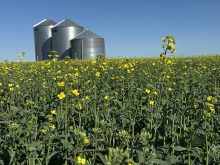Fed market weakens
Fed cattle prices drifted lower during the week.
Fed steers averaged $3.50 per hundredweight lower than the week before, while heifers were down $4.75, said Canfax.
Increased moisture across Alberta has led to mud and manure problems and some cattle prices reflected that. Fed cattle futures fell due to worries that terrorism threats in the United States would reduce restaurant dining.
The stronger Canadian dollar and weaker United States cash market encouraged few buyers from the south.
Volume was four percent lower than the week before at about 16,800 head, said Canfax.
Read Also

Huge Black Sea flax crop to provide stiff competition
Russia and Kazakhstan harvested huge flax crops and will be providing stiff competition in China and the EU.
In light Alberta trade Feb. 13, steers were $110-$112.35 per cwt., flat rail $184.75-$187.70 and heifers $110-$111, said Canfax.
Calgary wholesale beef prices this week are steady to $3 lower at $177-$185 per cwt. The eastern market is mixed at $190-$192.
Most plants have reduced kill levels in recent weeks to manage tight market-ready supplies. The Family Day holiday in Alberta would limit kill to four days this week.
The lower U.S. cash and futures market and the smaller kill schedules here will likely cause the Canadian cash market to be steady this week, Canfax said.
Feeder markets
Feeder steer prices were mostly steady, but 600-700 lb. steers increased $1.25 per cwt.
Heifers over 700 lb. were steady while lighter feeders were mostly $1.25-$2 stronger with 300-400 lb. heifers $3.25 higher.
Given the strength of the loonie, most of the trade was local. Slightly more than 47,000 head of cattle were sold in Alberta, an increase of 30 percent over the previous week’s volume but 21 percent below last year.
Slaughter cow prices were mostly steady but the average increased 25 cents per cwt.
Canfax said prices for lighter feeder cattle should remain steady as buyers look at increased moisture levels and start to think about summer grass cattle.
Heavier feeders will likely be steady to slightly lower.
In stock cow trade, bred cow and heifer trade volume was light. Bred cows were $600-$1,450, with most at $950-$1,300. Bred heifers were $800-$1,450, with most at $1,000- $1,350. A few cow-calf pairs sold at $1,150-$1,300.
Cattle-on-feed reports
The U.S. Department of Agriculture Feb. 1 cattle-on-feed report was fairly neutral. The placement figure was close to analyst estimates at 98 percent of last year.
The marketing number was slightly lower than expected, at 95 percent of last year. Total on feed in the U.S. was 92 percent of last year, in line with analysts’ guesses.
The Feb. 1 Alberta and Saskatchewan cattle-on-feed report supported the trend of fewer cattle on feed and tighter market-ready fed supplies.
Total on feed as of Feb. 1 was 775,912 head, about 300,000 head fewer than last year.
Placements in January were 165,001 head, about 17,000 head more than the same month last year.
Feeder cattle exports to the U.S. in the first five weeks of 2003 were slightly more than 28,000 head, 46 percent fewer than last year when almost 50,000 were exported.
January marketings were 17,600 head larger than last year. Earlier placements of yearlings in July and August this year contributed to some of the additional fed cattle marketings in January.
Excellent rates of gain and profitable feeding margins in November and December also increased the number of cattle for sale in January.
Pork cuts cheaper
A decline in wholesale prices for pork loins and hams lowered the U.S. pork cut-out value slightly by the end of the week.
Hog slaughter for the week was greater than a year ago despite projections that marketings would start to decline.
As a result, hog prices are about 11 percent below last year at this time.
Manitoba Agriculture noted that hog prices are now in the middle of the range projected last fall for the first quarter 2003. The department said it appears the hog supply-price relationship has returned to the level of the mid-1990s rather than continuing the extreme volatility of the past few years.
Hog prices strengthened at mid-week, but declined a day later in response to the lack of optimism in all meat markets.
The Iowa-Minnesota daily direct hog price (plant mean, 51-52 percent, lean carcass converted to live weight) rose from $35.79 US per cwt. on Feb. 10, to a high of $36.78 Feb. 12.
On average, the week’s price was about one percent below the previous week’s price.
















